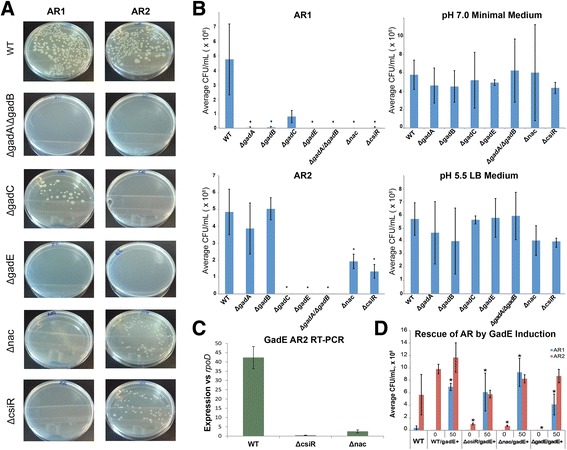Fig. 3.

Validation of a Proposed Mechanism for AR1. We hypothesized that AR1 may be mediated by the AR2 machinery using an internal source of glutamate. Our regulatory network implicates both nac and csiR in this process. We tested this hypothesis by examining the phenotype of several deletion mutants in acid stress assays using published protocols for inducing AR1 or AR2, along with positive and negative controls (Castanie-Cornet et al. [11]; Lin et al [4]). Acid stress assays consisted of overnight culture, acid challenge at pH 2.5 for 2 h, followed by plating, overnight incubation, and colony counting (Methods). a Example plates for one experiment for selected mutants comparing AR1 conditions to AR2 conditions. b Summary of colony counts averages for all mutants across all experiments for AR1, AR2, and for two non-acidic control growth conditions (for which strains were plated directly after overnight incubation without acid challenge) for 3 replicates (n = 3). Colony counts provided to allow comparison to control WT data. Resulting counts were tested at a significance level of α = 0.05 (* p-value < 0.05). Plots of % survival for AR1 and AR2 are provide in Additional file 1: Figure S6 c RT-PCR of gadE in WT, ΔcsiR, and Δnac from colonies recovered after acid challenge following AR2 induction (n = 3 for all). d AR Rescue of KO strains via induction of gadE showing the summary of colony counts averages for WT, ΔcsiR, Δnac and ΔgadE with gadE induced in AR1 and AR2 conditions for 3 replicate experiments (n =3). Numbers on the x-axis above strain names indicate amount of aTc added during AR challenge in ng/μL. Resulting counts were tested at a significance level of α = 0.05 (* p-value < 0.05)
